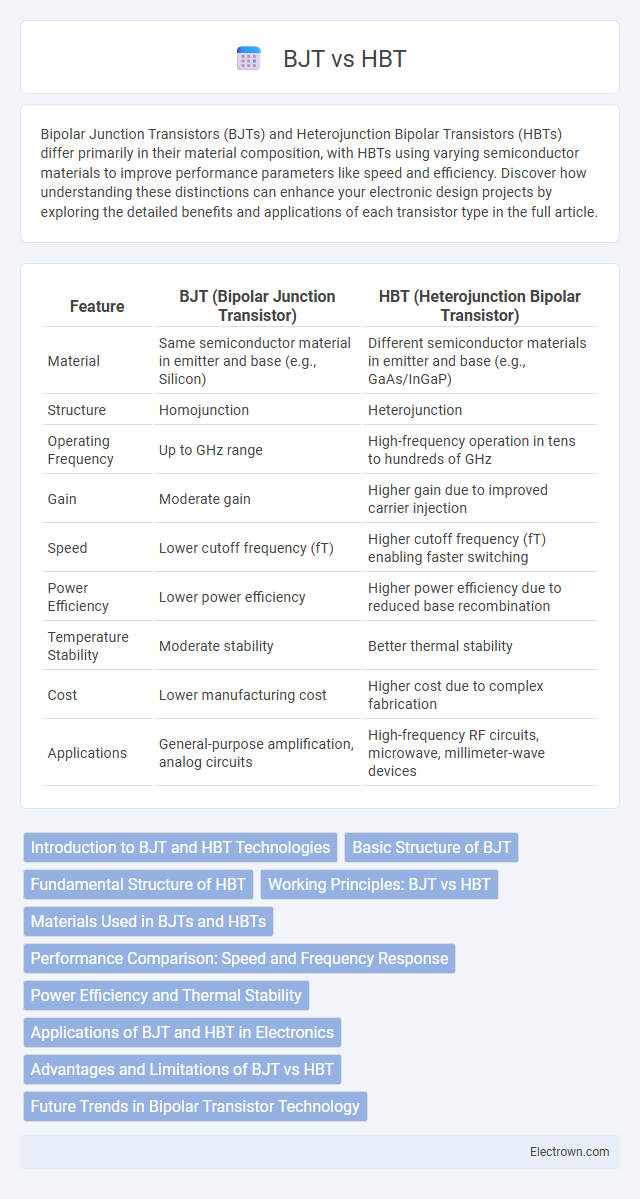Bipolar Junction Transistors (BJTs) and Heterojunction Bipolar Transistors (HBTs) differ primarily in their material composition, with HBTs using varying semiconductor materials to improve performance parameters like speed and efficiency. Discover how understanding these distinctions can enhance your electronic design projects by exploring the detailed benefits and applications of each transistor type in the full article.
Table of Comparison
| Feature | BJT (Bipolar Junction Transistor) | HBT (Heterojunction Bipolar Transistor) |
|---|---|---|
| Material | Same semiconductor material in emitter and base (e.g., Silicon) | Different semiconductor materials in emitter and base (e.g., GaAs/InGaP) |
| Structure | Homojunction | Heterojunction |
| Operating Frequency | Up to GHz range | High-frequency operation in tens to hundreds of GHz |
| Gain | Moderate gain | Higher gain due to improved carrier injection |
| Speed | Lower cutoff frequency (fT) | Higher cutoff frequency (fT) enabling faster switching |
| Power Efficiency | Lower power efficiency | Higher power efficiency due to reduced base recombination |
| Temperature Stability | Moderate stability | Better thermal stability |
| Cost | Lower manufacturing cost | Higher cost due to complex fabrication |
| Applications | General-purpose amplification, analog circuits | High-frequency RF circuits, microwave, millimeter-wave devices |
Introduction to BJT and HBT Technologies
Bipolar Junction Transistors (BJT) utilize silicon-based semiconductor materials with three layers--emitter, base, and collector--to amplify current through charge carrier injection. Heterojunction Bipolar Transistors (HBT) incorporate different semiconductor materials, such as gallium arsenide (GaAs) or silicon-germanium (SiGe), creating heterojunctions that improve electron mobility and frequency response. Understanding the distinctions in material composition and structure helps optimize your choice for high-speed, high-frequency applications in modern electronics.
Basic Structure of BJT
The basic structure of a Bipolar Junction Transistor (BJT) consists of three layers of semiconductor material forming two p-n junctions, arranged as either NPN or PNP types. Each layer serves as the emitter, base, or collector, where the thin and lightly doped base controls the injection of charge carriers between the heavily doped emitter and collector. This configuration enables the BJT to amplify current by controlling the flow of electrons and holes across the junctions in response to input signals.
Fundamental Structure of HBT
Heterojunction Bipolar Transistors (HBTs) differ from Bipolar Junction Transistors (BJTs) primarily in their fundamental structure, where HBTs utilize a heterojunction between different semiconductor materials, typically combining GaAs and AlGaAs, to form the emitter-base junction instead of the homojunction in BJTs. This heterojunction enables improved carrier injection efficiency, higher operating frequencies, and better performance in high-speed and high-frequency applications. Understanding the fundamental structure of HBT is essential for optimizing your designs in RF and microwave circuits.
Working Principles: BJT vs HBT
Bipolar Junction Transistors (BJTs) operate by injecting electrons and holes across a p-n junction, generating current through charge carrier diffusion in three semiconductor regions--emitter, base, and collector. Heterojunction Bipolar Transistors (HBTs) utilize different semiconductor materials with varying bandgaps at the emitter-base junction, improving electron injection efficiency and enabling faster switching speeds. Understanding these working principle differences helps optimize Your circuit performance for speed and frequency response.
Materials Used in BJTs and HBTs
BJTs primarily utilize silicon or germanium semiconductors, offering reliable performance for general-purpose amplification and switching. HBTs employ compound semiconductor materials such as gallium arsenide (GaAs) or indium phosphide (InP), which provide superior electron mobility and higher frequency operation. The choice of materials in HBTs enables enhanced gain and efficiency in microwave and high-speed analog circuits compared to traditional BJTs.
Performance Comparison: Speed and Frequency Response
Heterojunction Bipolar Transistors (HBTs) outperform Bipolar Junction Transistors (BJTs) in speed and frequency response due to their use of different semiconductor materials, which create a heterojunction that reduces charge storage and enhances electron mobility. HBTs achieve higher cutoff frequencies (fT) and maximum oscillation frequencies (fmax), making them ideal for high-frequency applications like RF and microwave circuits. Your high-speed design benefits from the superior switching speed and improved gain-bandwidth product offered by HBT technology.
Power Efficiency and Thermal Stability
Heterojunction Bipolar Transistors (HBTs) offer superior power efficiency compared to Bipolar Junction Transistors (BJTs) due to their higher current gain and reduced base resistance, enabling better performance at high frequencies. HBTs also exhibit enhanced thermal stability because of their heterojunction structure, which minimizes leakage currents and maintains consistent operation across a wider temperature range. If your application requires efficient power handling and reliable thermal performance, choosing HBTs can significantly improve overall device longevity and functionality.
Applications of BJT and HBT in Electronics
Bipolar Junction Transistors (BJTs) are extensively used in analog circuits, such as amplifiers, switches, and signal processing devices, due to their high current gain and linearity. Heterojunction Bipolar Transistors (HBTs) are preferred in high-frequency and high-speed applications like RF amplifiers, microwave transmitters, and wireless communication systems because of their superior electron mobility and cutoff frequency. The integration of HBTs in modern communication devices enhances signal amplification and switching speed, driving advancements in 5G technology and satellite communications.
Advantages and Limitations of BJT vs HBT
Bipolar Junction Transistors (BJT) offer high current density and robustness, making them suitable for power amplification and switching applications, but they suffer from limited high-frequency performance due to lower transit speeds. Heterojunction Bipolar Transistors (HBT) provide superior frequency response, higher gain, and greater efficiency by utilizing different semiconductor materials at the junctions, enhancing carrier injection and reducing noise. Your choice depends on whether you prioritize cost-effective durability with BJTs or high-speed, high-frequency operation with HBTs.
Future Trends in Bipolar Transistor Technology
Future trends in bipolar transistor technology highlight the increasing adoption of Heterojunction Bipolar Transistors (HBTs) due to their superior frequency response and efficiency compared to traditional Bipolar Junction Transistors (BJTs). Advances in semiconductor materials, such as silicon-germanium and III-V compounds, enhance HBT performance in high-speed and high-frequency applications, driving innovation in 5G, radar, and aerospace technologies. Continued scaling and integration strategies aim to optimize power consumption and thermal management, ensuring HBTs remain the preferred choice for next-generation communication and high-performance electronic devices.
BJT vs HBT Infographic

 electrown.com
electrown.com